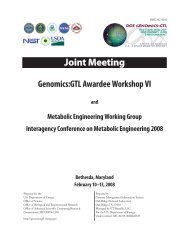Joint Meeting - Genomics - U.S. Department of Energy
Joint Meeting - Genomics - U.S. Department of Energy
Joint Meeting - Genomics - U.S. Department of Energy
Create successful ePaper yourself
Turn your PDF publications into a flip-book with our unique Google optimized e-Paper software.
Milestone 1<br />
We seek scientists to adopt and curate individual PGDBs within the BioCyc collection. Only by harnessing<br />
the expertise <strong>of</strong> many scientists can we hope to produce biological databases that accurately<br />
capture the depth and breadth <strong>of</strong> biomedical knowledge. To adopt a database, send email to biocycsupport@ai.sri.com.<br />
The Pathway Tools s<strong>of</strong>tware that powers the BioCyc Web site provides powerful query and visualization<br />
operations for each BioCyc database. For example, the Omics viewer allows scientists to visualize<br />
combinations <strong>of</strong> gene expression, proteomics, and metabolomics data on the metabolic map <strong>of</strong><br />
an organism (see http://biocyc.org/ov-expr.shtml). A genome browser permits interactive exploration<br />
<strong>of</strong> either a single genome, or <strong>of</strong> orthologous regions <strong>of</strong> multiple genomes. A newly developed set <strong>of</strong><br />
comparative genomics tools supports many comparisons across the genomes and metabolic networks<br />
<strong>of</strong> the BioCyc collection. See http://biocyc.org/samples.shtml for an overview <strong>of</strong> BioCyc Web site<br />
functionality.<br />
The MetaCyc database 3 describes experimentally elucidated metabolic pathways and enzymes as<br />
reported in the experimental literature. MetaCyc is both an online reference source on metabolic<br />
pathways and enzymes, and a solid foundation <strong>of</strong> experimentally proven pathways for use in computational<br />
pathway prediction. MetaCyc version 9.6 describes 690 pathways from more than 600<br />
organisms. The 5500 biochemical reactions in MetaCyc reference 4800 chemical substrates, most <strong>of</strong><br />
which contain chemical structure information. MetaCyc describes the properties <strong>of</strong> 3000 enzymes,<br />
such as their subunit structure, c<strong>of</strong>actors, activators, inhibitors, and in some cases their kinetic<br />
parameters. The information in MetaCyc was obtained from more than 8500 research articles, and<br />
emphasizes pathways and enzymes from microbes and plants.<br />
References<br />
1. P.D. Karp et al, “Expansion <strong>of</strong> the BioCyc Collection <strong>of</strong> Pathway/Genome Databases to 160 Genomes,”<br />
Nucleic Acids Research 33:6083-9 2005.<br />
2.<br />
3.<br />
8 * Presenting author<br />
P.D. Karp et al, “The Pathway Tools S<strong>of</strong>tware,” Bioinformatics 18:S225-32 2002.<br />
R. Caspi et al, “MetaCyc: A multiorganism database <strong>of</strong> metabolic pathways and enzymes,” Nucleic Acids<br />
Research in press, 2006 Database issue.<br />
5 Bioinformatic Methods Applied to Prediction <strong>of</strong> Bacterial Gene<br />
Function<br />
Michelle Green 1 * (green@ai.sri.com), Balaji Srinivasan 2 , Peter Karp 1 , and Harley McAdams 2<br />
1 SRI International, Menlo Park, CA and 2 Stanford University, Stanford, CA<br />
We have applied two different bioinformatic methods to prediction <strong>of</strong> the function <strong>of</strong> Caulobacter<br />
gene products. First, we used the PathoLogic program to construct Pathway/Genome databases<br />
using the genome’s annotation to predict the set <strong>of</strong> metabolic pathways present. PathoLogic determines<br />
the set <strong>of</strong> reactions composing those pathways from the list <strong>of</strong> enzymes in the organism.<br />
Enzymes in a genome are <strong>of</strong>ten missed or assigned a non-specific function (e.g., “thiolase family protein”)<br />
during the initial annotation. These incomplete annotations result in “pathway holes” where the<br />
genome appears to lack the enzymes known to be needed to catalyze reactions in a pathway. Second,<br />
we combined gene co-conservation determined from 230 sequenced bacterial genomes with four





